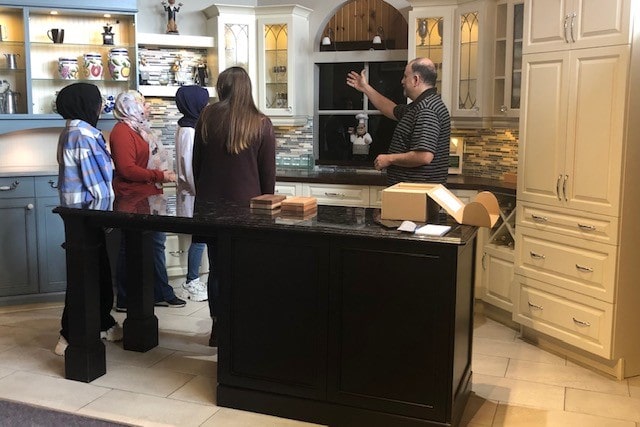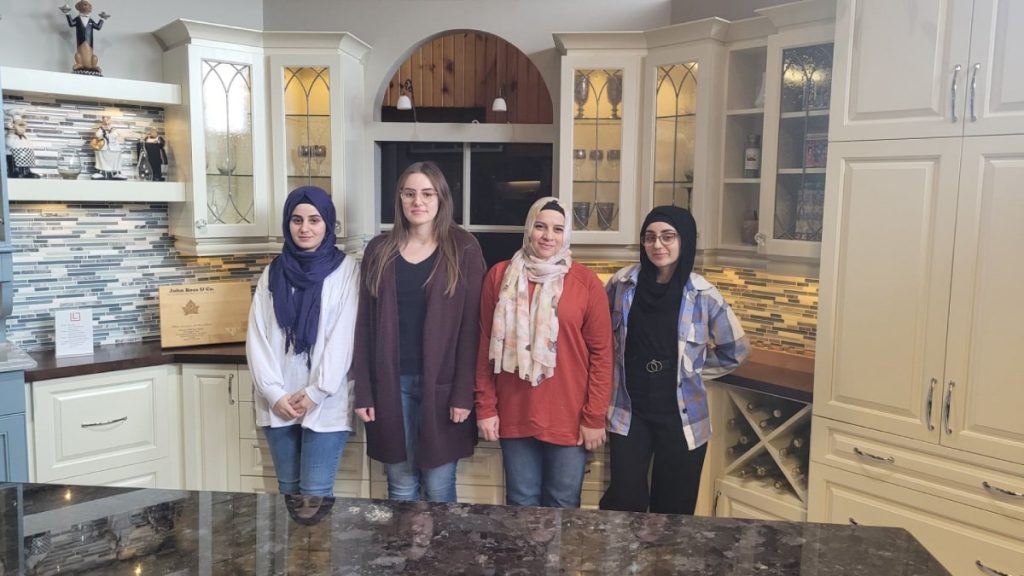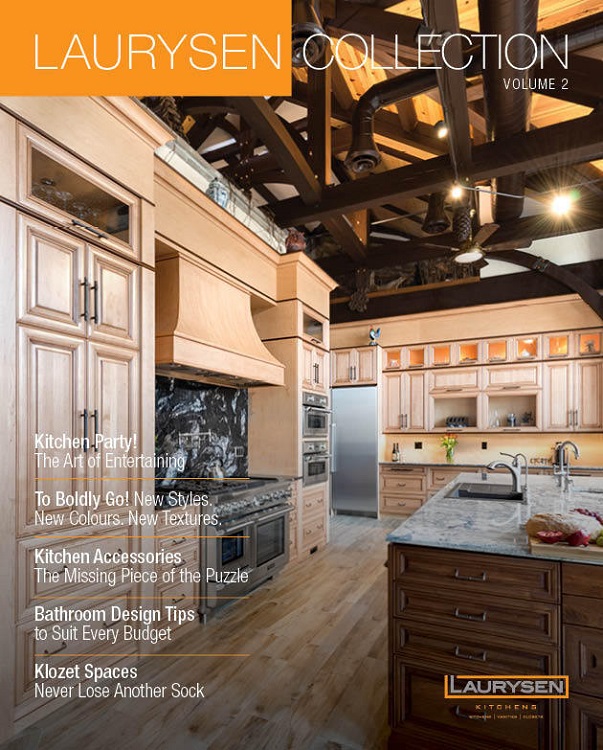
At Laurysen Kitchens, we believe that experience speaks volumes. That’s why we’ve partnered with Algonquin College to build the skills and passions of aspiring talents.
Recently, we sat down with Wael Bakr, Design Manager and Certified Master Kitchen and Bath Designer (CMKBD), and former co-op students (now Laurysen employees) Kayla Driscoll and Rabab Filfil, to explore Laurysen’s field placement program. We discussed the hands-on experience and how it contributes to the growth and development of aspiring designers in the industry.
What does Laurysen’s partnership with Algonquin College look like?
Wael: We’ve been working with Algonquin College for about 15 years now. The school’s design offerings have changed over the years, but currently, they have a two-year Interior Decorating program and a four-year Honours Interior Design program. Both programs go well beyond theoretical classroom work and focus on real-world experiences. Laurysen takes on co-op students for a field placement each year.
How many students does Laurysen usually accept for its program, and how long is the placement?
Wael: Laurysen typically accepts three to four students from mid-January to nearly the end of April. During this period, they must dedicate 84 hours on-site to meet the program’s graduation requirements. This commitment usually ends up being approximately four to eight hours per week. And we make those hours count!

Do the students have a choice in selecting where they want to do their placement?
Rabab: Yes, we are required to actively search for a company that aligns with our career goals. It’s a personal responsibility for each student to find their own field placement.
What drew you to Laurysen as a company for your placement?
Kayla: Personally, I wanted to delve into kitchen and bath design, and the fact that Laurysen has its own manufacturing plant was also quite intriguing.
What does field placement at Laurysen Kitchens look like, and who at the company is involved?
Wael: In addition to spending lots of time in the showroom shadowing our designers, the students also work with several key individuals to ensure they are exposed to all the different aspects of Laurysen. Here are some of the things we cover and the people the students work with:
- Catalogue: Corey Laurysen, our Vice President of Sales and Service, walks the students through our catalogue, providing insights into our unique cabinets, specifications, and accessories.
- Plant Tours: Michael Laurysen, Vice President of Operations, conducts plant tours where students get an in-depth look into the entire cabinet manufacturing process—from raw materials to the finished product on the assembly line.
- Closets and Other Rooms: Colleen Castrucci, our CEO, guides students through specialized other spaces (beyond kitchens and baths) that Laurysen designs, such as closets, pantries, basements and built-ins.
- 2020 Design Software: Victoria Campbell, our Design Operations Manager, takes the lead on our Design 2020 software, an industry standard that’s an essential tool in kitchen and bath design.
- Human Resources: Christine Paxton, our HR Manager, plays a vital role by covering regulations, workplace ethics, and safety protocols with the students. This aspect is crucial to prepare students to enter the workforce responsibly.
- Design & Products: As the Design Manager, I spend a lot of time with the students. I instruct them on design principles, and we also discuss topics such as wood species, countertops, cabinet door styles, colours, cabinet accessories and much more to build product knowledge.
- Client Meetings: I also arrange shadowing opportunities with our Laurysen designers, where the students learn essential skills like understanding client preferences, effective communication and professionalism.
These professionals, some with 15-20 years of industry experience, offer more than just textbook knowledge; they provide a hands-on understanding of the trade. The students are present during actual client appointments to gain valuable insights by observing and absorbing the dynamics of these interactions.
Does Algonquin College plan the field placement activities, or does Laurysen organize the program?
Wael: It’s all our own! At Laurysen, we’ve worked hard to design an experience that prepares students for their professional careers and ensures they are ready for the next step in their journey.
How difficult is it to learn and use the 2020 Design software?
Kayla: It was a bit tricky initially, learning new things. Thankfully, Victoria Campbell was there to help with any questions.
Rabab: We started by exploring the software gradually and then moved on to the final assignment, which involved designing a kitchen and making a presentation. Victoria provided helpful videos to help make learning easier.
What assignments are the students asked to complete? What is required for the final presentation?
Wael: First, we typically hold weekly meetings and conduct lecture-like sessions. After each of these meetings, the students are given small assignments. For instance, if the topic is wood species, the task would be to compare the characteristics of Cherry Wood and Birchwood. They do some research and bring in their answers the next time we meet.
We also assign a substantial design project to the students. Each student works on an individual kitchen and formally presents their work in April. Their audience is me, all the other individuals I mentioned earlier and several designers. There are about twelve people in the room, so it’s a little intimidating.
This project is a real-life case study that mimics an actual client with specific requirements—for example, it might be a couple with kids and a dog. The students are asked to present and defend their project, justifying every aspect of their design and explaining why they made certain decisions, including colour, material and accessory choices. The final presentation is always well-received by everyone involved and serves as a meaningful conclusion to the program.
That sounds like a lot of work! As a student, what did you think about the final presentation assignment?
Kayla: Our final assignment had a challenging floor plan and a sizable window, which was a bit of a curveball. Our task was to overcome these challenges and strategically place the cabinets. It wasn’t a one-shot deal; we could present our work to Wael. He provided us with feedback, and then we could make adjustments and tweaks along the way based on his insights. It was a great practical experience that made us think on our feet and refine our designs to address real-world challenges.
What benefits did you gain from Laurysen’s field placement program as a student?
Rabab: The first year of our two-year program at Algonquin College was all online. But once we stepped into Laurysen, it was a game-changer. The in-person work experience is invaluable. I was so happy to get hands-on experience and knowledge of materials, countertops, and door styles because it goes way beyond textbooks. Being immersed like that is crucial for a new designer; feeling and touching every aspect really gives you that edge.
Also, an expert meticulously covered every step as we tackled the design process. We learned so much information that became the foundation for other assignments and courses.
I also loved to see the dynamic between designers and suppliers. You quickly learn that design is not just about trends and colours; it’s about installation, understanding the customer’s needs, and applying that to your design. Everything we did was practical and useful.
Kayla: Also, being in a small group was really valuable for me. It made the learning more personal and a lot easier to grasp.
What qualities or skills make a student successful in Laurysen’s field placement program?
Wael: Honestly, it boils down to one thing: being serious. I appreciate students who approach their work with the right attitude. Timely completion of assignments and professionalism—these attributes are key to being successful in this industry. That’s why we expose them to senior designers; it’s a lesson in professionalism.
I made it clear from day one: if you’re here just for the hours, it’s not the right place for you. But if you’re here to learn and prepare for your professional journey, we’re happy to have you.
We don’t take this program lightly; we’re all in and want them to be, too!
Rabab: Having passion for the work you do is the key. You have to work from your heart.
Now that you’ve finished the program, what are your thoughts on Laurysen’s field placement experience?
Rabab: I definitely think our group was the hardest working group in the co-op program. While others were asked to clean showrooms, we were learning new programs and deep into research and assignments every week. As far as we know, that wasn’t the norm for other groups. We feel fortunate and grateful for this unique experience. At the end of every day, we didn’t feel like students; we felt like part of the Laurysen family, and that boosted our confidence.
How is the field placement program beneficial for Laurysen?
Wael: Honestly, it’s a win-win for everyone involved.
Our goal is that once these students graduate, they’re ready to be hired immediately, and you have two living examples right here with Rabab and Kayla. And they’re not the only ones we’ve brought on board. Over the 15 years of our partnership with Algonquin College, we’ve consistently hired one or two students every year.
Students who have completed the field placement can hit the ground running; there’s no need to start from scratch with them. It’s about preparing them for the real deal, whether with another company or with us.
Also, this program really aligns with our values and allows Laurysen to support our community, which is part of our company culture. We’re actively engaged with local initiatives like the Minto Communities CHEO Dream Home.
We welcome students because we want to support them, give back to the community, and foster talent in our industry. And, being a sizable company, there are opportunities beyond design positions at Laurysen.
Does Laurysen offer field placement opportunities for other positions at the company?
Wael: Absolutely, our co-op program extends beyond design. Christine Paxton, our Human Resources Manager, works closely with various schools. It’s not exclusive to Algonquin College; we welcome students from different colleges and universities.
We have co-op students exploring roles across the company. For instance, we recently had someone interested in administration. They spent time with our admin team, delving into tasks from accounting to front desk responsibilities. We also consistently have students working with Michael Laurysen in the shop, learning about business operations, plus carpentry, assembly and finishing techniques.
How can I learn more about a career at Laurysen Kitchens?
If you’re interested in co-op opportunities or job positions at Laurysen, reach out to Christine Paxton, our Human Resources Manager, for more information. She can guide you through the available opportunities and help you take the first steps toward a rewarding career with us!
